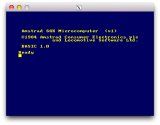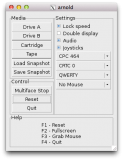If you really must try this on your on Amstrad CPC:
Tag: amstrad
For completeness: Level 9 “Snowball” bitmap font
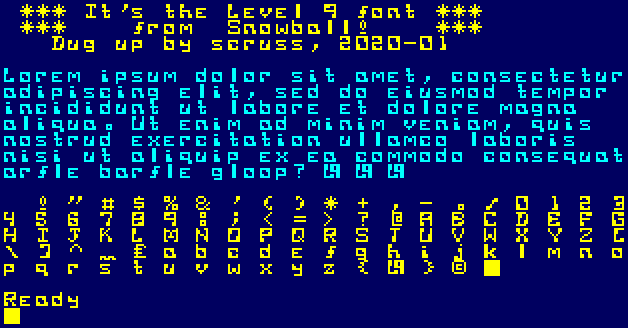
Oooh blecch — did I really like this when I was a young ‘un? Following on from the same process as in The coolest font (when I was 15, that is) here’s the bitmap font from Level 9’s Snowball.
10 REM *** L9SFONT.BAS *** 15 REM bitmap font from Level 9's 20 REM Snowball text adventure 30 REM on the Amstrad CPC 464 40 REM (it was so cool at the time ...) 50 REM Dug up by scruss, 2020-01 60 REM ============================== 100 SYMBOL AFTER 32 110 MODE 1 120 GOSUB 1000 130 PRINT" *** It's the Level 9 font ***" 140 PRINT" *** from Snowball! ***" 150 PRINT" Dug up by scruss, 2020-01" 160 PRINT 170 PEN 2 180 PRINT"Lorem ipsum dolor sit amet, consectetur" 190 PRINT"adipiscing elit, sed do eiusmod tempor" 200 PRINT"incididunt ut labore et dolore magna" 210 PRINT"aliqua. Ut enim ad minim veniam, quis" 220 PRINT"nostrud exercitation ullamco laboris" 230 PRINT"nisi ut aliquip ex ea commodo consequat" 240 PRINT"arfle barfle gloop? | | |" 250 PRINT 260 PEN 1 270 FOR i%=32 TO 127 280 PRINT CHR$(i%); " "; 290 NEXT i% 300 PRINT 310 PRINT 990 END 1000 SYMBOL 33,&10,&28,&28,&28,&10,0,&38,0 1010 SYMBOL 34,&66,&66,&44,&88,0,0,0,0 1020 SYMBOL 35,0,&24,&7e,&24,&24,&7e,&24,0 1030 SYMBOL 36,&10,&7c,&40,&7c,&04,&7c,&10,0 1040 SYMBOL 37,&e4,&a4,&e8,&10,&2e,&4a,&4e,0 1050 SYMBOL 38,&70,&88,&88,&72,&84,&88,&76,0 1060 SYMBOL 39,&0c,&0c,&08,&10,0,0,0,0 1070 SYMBOL 40,&0c,&10,&30,&30,&20,&14,&0c,0 1080 SYMBOL 41,&30,&28,&04,&0c,&0c,&08,&30,0 1090 SYMBOL 42,&10,&54,&38,&fe,&38,&54,&10,0 1100 SYMBOL 43,0,&10,&10,&7c,&10,&10,0,0 1110 SYMBOL 44,0,0,0,0,&18,&18,&10,&20 1120 SYMBOL 45,0,0,0,&fc,0,0,0,0 1130 SYMBOL 46,0,0,0,0,&1c,&14,&1c,0 1140 SYMBOL 47,0,&06,&0e,&08,&10,&70,&60,0 1150 SYMBOL 48,&fc,&8c,&8c,&84,&c4,&c4,&fc,0 1160 SYMBOL 49,&30,&10,&10,&10,&18,&18,&38,0 1170 SYMBOL 50,&f8,&98,&08,&f8,&80,&c8,&f8,0 1180 SYMBOL 51,&7c,&64,&04,&3c,&34,&04,&7c,0 1190 SYMBOL 52,&c8,&88,&88,&f8,&08,&18,&18,0 1200 SYMBOL 53,&f8,&98,&80,&f0,&08,&c8,&f0,0 1210 SYMBOL 54,&78,&98,&80,&f8,&98,&c8,&f8,0 1220 SYMBOL 55,&fc,&c4,&04,&08,&08,&18,&18,0 1230 SYMBOL 56,&fc,&c4,&8c,&fc,&84,&9c,&fc,0 1240 SYMBOL 57,&fc,&e4,&84,&fc,&04,&0c,&0c,0 1250 SYMBOL 58,&38,&28,&38,0,&38,&28,&38,0 1260 SYMBOL 59,&18,&18,0,&18,&18,&10,&20,0 1270 SYMBOL 60,&04,&08,&10,&20,&10,&08,&04,0 1280 SYMBOL 61,0,0,&7e,0,&7e,0,0,0 1290 SYMBOL 62,&80,&40,&20,&10,&20,&40,&80,0 1300 SYMBOL 63,&7c,&04,&1c,&10,&10,0,&10,0 1310 SYMBOL 64,&3e,&22,&2e,&2a,&2e,&20,&3e,0 1320 SYMBOL 65,&fc,&c4,&8c,&fc,&84,&c4,&c4,0 1330 SYMBOL 66,&f8,&84,&e4,&f8,&84,&9c,&f8,0 1340 SYMBOL 67,&fc,&8c,&80,&80,&c0,&c4,&fc,0 1350 SYMBOL 68,&f8,&64,&64,&44,&4c,&4c,&f8,0 1360 SYMBOL 69,&fc,&8c,&c0,&f8,&c0,&8c,&fc,0 1370 SYMBOL 70,&fc,&9c,&80,&f8,&80,&c0,&c0,0 1380 SYMBOL 71,&fc,&9c,&80,&9c,&c4,&c4,&fc,0 1390 SYMBOL 72,&c4,&c4,&84,&fc,&84,&8c,&8c,0 1400 SYMBOL 73,&7c,&14,&10,&10,&10,&50,&7c,0 1410 SYMBOL 74,&7c,&54,&10,&18,&18,&90,&60,0 1420 SYMBOL 75,&c8,&90,&a0,&d0,&88,&8c,&8c,0 1430 SYMBOL 76,&c0,&c0,&c0,&80,&80,&98,&f8,0 1440 SYMBOL 77,&82,&ee,&92,&92,&ba,&82,&c6,0 1450 SYMBOL 78,&8c,&c4,&c4,&b4,&8c,&8c,&84,0 1460 SYMBOL 79,&fc,&c4,&c4,&84,&8c,&8c,&fc,0 1470 SYMBOL 80,&fc,&c4,&8c,&fc,&80,&c0,&c0,0 1480 SYMBOL 81,&fc,&c4,&c4,&84,&94,&88,&f4,0 1490 SYMBOL 82,&fc,&c4,&8c,&fc,&90,&c8,&cc,0 1500 SYMBOL 83,&fc,&84,&80,&78,&04,&84,&fc,0 1510 SYMBOL 84,&7c,&10,&10,&10,&30,&30,&30,0 1520 SYMBOL 85,&c4,&c4,&84,&8c,&8c,&8c,&fc,0 1530 SYMBOL 86,&c4,&84,&84,&48,&48,&30,&30,0 1540 SYMBOL 87,&84,&84,&84,&b4,&b4,&cc,&84,0 1550 SYMBOL 88,&cc,&cc,&48,&30,&48,&cc,&cc,0 1560 SYMBOL 89,&86,&86,&44,&28,&10,&18,&18,0 1570 SYMBOL 90,&fc,&84,&08,&30,&40,&84,&fc,0 1580 SYMBOL 91,&7c,&60,&60,&40,&40,&4c,&7c,0 1590 SYMBOL 92,0,&60,&30,&10,&08,&0c,&06,0 1600 SYMBOL 93,&3e,&32,&02,&02,&06,&06,&3e,0 1610 SYMBOL 94,&18,&24,&42,&42,0,0,0,0 1620 SYMBOL 95,0,0,0,0,0,0,&ee,&bb 1630 SYMBOL 96,&3c,&22,&78,&20,&78,&20,&7e,0 1640 SYMBOL 97,0,0,&f8,&98,&88,&cc,&fc,0 1650 SYMBOL 98,&80,&80,&f8,&98,&88,&c8,&f8,0 1660 SYMBOL 99,0,0,&f8,&88,&c0,&c8,&f8,0 1670 SYMBOL 100,&08,&08,&f8,&98,&88,&c8,&f8,0 1680 SYMBOL 101,0,0,&f8,&80,&e0,&80,&f8,0 1690 SYMBOL 102,0,&1c,&10,&38,&38,&10,&70,0 1700 SYMBOL 103,0,0,&f8,&98,&88,&f8,&08,&78 1710 SYMBOL 104,&c0,&c0,&80,&f8,&88,&cc,&cc,0 1720 SYMBOL 105,0,&60,0,&60,&60,&70,&70,0 1730 SYMBOL 106,&08,0,&18,&18,&08,&08,&68,&78 1740 SYMBOL 107,&c0,&c0,&cc,&d8,&f0,&d8,&cc,0 1750 SYMBOL 108,&30,&30,&30,&30,&30,&30,&30,0 1760 SYMBOL 109,0,0,&cc,&b4,&b4,&84,&84,0 1770 SYMBOL 110,0,0,&f8,&98,&88,&cc,&cc,0 1780 SYMBOL 111,0,0,&f8,&98,&88,&c8,&f8,0 1790 SYMBOL 112,0,0,&f8,&98,&88,&f8,&80,&80 1800 SYMBOL 113,0,0,&f8,&88,&c8,&f8,&0c,&0c 1810 SYMBOL 114,0,0,&f8,&98,&80,&c0,&c0,0 1820 SYMBOL 115,0,0,&f8,&80,&70,&08,&f8,0 1830 SYMBOL 116,&60,&60,&20,&78,&20,&28,&38,0 1840 SYMBOL 117,0,0,&c8,&c8,&98,&98,&f8,0 1850 SYMBOL 118,0,0,&cc,&cc,&88,&70,&20,0 1860 SYMBOL 119,0,0,&84,&84,&b4,&b4,&cc,0 1870 SYMBOL 120,0,0,&cc,&48,&30,&48,&cc,0 1880 SYMBOL 121,0,0,&88,&c8,&f8,&08,&08,&78 1890 SYMBOL 122,0,0,&f8,&90,&20,&48,&f8,0 1900 SYMBOL 123,&0c,&30,&10,&60,&10,&30,&0c,0 1910 SYMBOL 124,&df,&db,&db,&9f,&83,&9b,&fb,0 1920 SYMBOL 125,&30,&0c,&08,&06,&08,&0c,&30,0 1930 SYMBOL 126,&7c,&82,&ba,&a2,&ba,&82,&7c,0 1940 SYMBOL 127,&FF,&FF,&FF,&FF,&FF,&FF,&FF,&FF 1950 RETURN
Process was the same:
- Load the disk image into an emulator
- Load the game
- Save the game as a v2 snapshot – these are uncompressed memory dumps
- Dump the snapshot to a png using phooky’s PROM/bin2png.py
- Crop that image down to just the character data and save as a plain PBM
- For each column, create the hex dump using shell code a bit like this:
sc=32; pnminvert snowball_font.pbm | pnmnoraw | tail +3 | cut --character="1-8"|while read f; do echo "printf '&%02x, \n' "\"\$((2#${f}))\"; done | bash | fmt -w43 | sed 's/,$//;' | while read g; do echo SYMBOL $sc", "$g; sc=$((sc + 1)); done | awk '{print 10 * (NR + 0) " " $0;}' > schars032to063.bas
TBH, the 901447-10m third-party font for the PET did the Data 70/Westminster faux-MICR thing better, and likely earlier too.
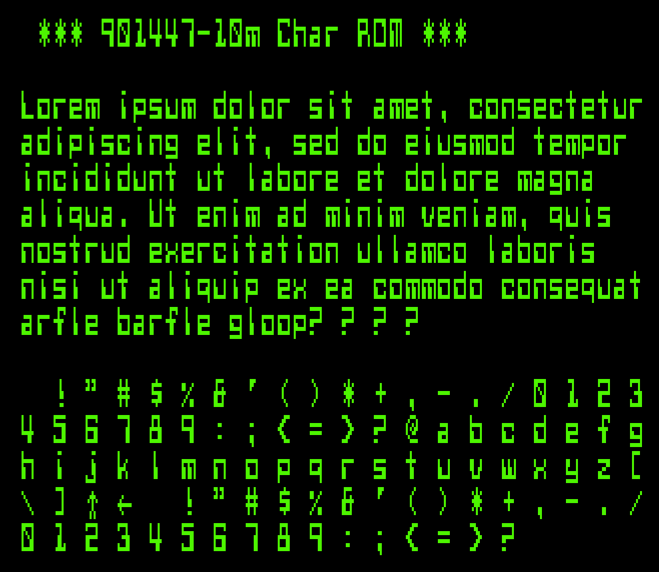
The coolest font (when I was 15, that is)
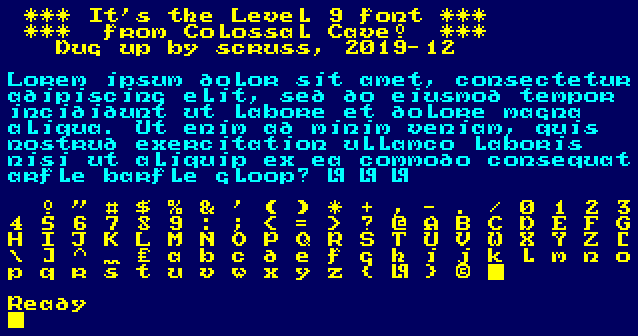
Though I didn’t really have the patience for text adventures, Level 9 used what I thought was the coolest font (circa 1985). After checking through them all on the Internet Archive Amstrad CPC software library, I couldn’t find a version that used this bitmap font. I eventually found it on nvg. After lots of messing about, I extracted it and present it here. I’m sure I’ll make a TTF of it soon enough.
Tastes change a bit, don’t they?
10 REM *** L9FONT.BAS *** 15 REM bitmap font from Level 9's 20 REM Colossal Cave adventure 30 REM on the Amstrad CPC 464 40 REM (it was so cool at the time…) 50 REM Dug up by scruss, 2019-12 60 REM ============================== 100 SYMBOL AFTER 32 110 MODE 1 120 GOSUB 1000 130 PRINT" *** It's the Level 9 font ***" 140 PRINT" *** from Colossal Cave! ***" 150 PRINT" Dug up by scruss, 2019-12" 160 PRINT 170 PEN 2 180 PRINT"Lorem ipsum dolor sit amet, consectetur" 190 PRINT"adipiscing elit, sed do eiusmod tempor" 200 PRINT"incididunt ut labore et dolore magna" 210 PRINT"aliqua. Ut enim ad minim veniam, quis" 220 PRINT"nostrud exercitation ullamco laboris" 230 PRINT"nisi ut aliquip ex ea commodo consequat" 240 PRINT"arfle barfle gloop? | | |" 250 PRINT 260 PEN 1 270 FOR i%=32 TO 127 280 PRINT CHR$(i%); " "; 290 NEXT i% 300 PRINT 310 PRINT 990 END 1000 SYMBOL 33,&18,&24,&24,&24,&18,&0,&18,&0 1010 SYMBOL 34,&66,&66,&44,&88,&0,&0,&0,&0 1020 SYMBOL 35,&0,&24,&7E,&24,&24,&7E,&24,&0 1030 SYMBOL 36,&12,&7C,&D0,&7C,&16,&FC,&10,&0 1040 SYMBOL 37,&E4,&A4,&E8,&10,&2E,&4A,&4E,&0 1050 SYMBOL 38,&70,&D8,&D8,&72,&D6,&CC,&76,&0 1060 SYMBOL 39,&30,&30,&20,&40,&0,&0,&0,&0 1070 SYMBOL 40,&1C,&38,&70,&70,&70,&38,&1C,&0 1080 SYMBOL 41,&70,&38,&1C,&1C,&1C,&38,&70,&0 1090 SYMBOL 42,&10,&54,&38,&FE,&38,&54,&10,&0 1100 SYMBOL 43,&0,&10,&10,&7C,&10,&10,&0,&0 1110 SYMBOL 44,&0,&0,&0,&0,&30,&30,&20,&40 1120 SYMBOL 45,&0,&0,&0,&F8,&0,&0,&0,&0 1130 SYMBOL 46,&0,&0,&0,&0,&0,&60,&60,&0 1140 SYMBOL 47,&0,&4,&8,&10,&20,&40,&0,&0 1150 SYMBOL 48,&7C,&C6,&CE,&D6,&E6,&C6,&7C,&0 1160 SYMBOL 49,&8,&18,&38,&18,&18,&18,&3C,&0 1170 SYMBOL 50,&3C,&66,&C,&18,&30,&62,&7E,&0 1180 SYMBOL 51,&7E,&4C,&18,&3C,&6,&66,&3C,&0 1190 SYMBOL 52,&4,&C,&1C,&2C,&7E,&C,&1E,&0 1200 SYMBOL 53,&3E,&66,&60,&7C,&6,&6,&7C,&0 1210 SYMBOL 54,&3C,&66,&60,&7C,&66,&66,&3C,&0 1220 SYMBOL 55,&7E,&46,&6,&C,&C,&18,&18,&0 1230 SYMBOL 56,&3C,&66,&34,&18,&2C,&66,&3C,&0 1240 SYMBOL 57,&3C,&66,&66,&3E,&6,&66,&3C,&0 1250 SYMBOL 58,&0,&30,&30,&0,&0,&30,&30,&0 1260 SYMBOL 59,&0,&30,&30,&0,&30,&30,&20,&40 1270 SYMBOL 60,&1C,&30,&60,&C0,&60,&30,&1C,&0 1280 SYMBOL 61,&0,&0,&F8,&0,&F8,&0,&0,&0 1290 SYMBOL 62,&E0,&30,&18,&C,&18,&30,&E0,&0 1300 SYMBOL 63,&7C,&64,&C,&18,&10,&0,&10,&0 1310 SYMBOL 64,&7C,&C6,&DE,&D2,&DE,&C0,&7E,&0 1320 SYMBOL 65,&18,&6C,&C6,&C6,&FE,&66,&F6,&0 1330 SYMBOL 66,&FC,&C6,&C6,&FC,&C6,&C6,&FC,&0 1340 SYMBOL 67,&3C,&66,&C0,&C0,&C0,&66,&3C,&0 1350 SYMBOL 68,&D8,&EC,&C6,&C6,&C6,&EC,&D8,&0 1360 SYMBOL 69,&FE,&62,&60,&78,&60,&62,&FE,&0 1370 SYMBOL 70,&FE,&62,&60,&78,&60,&60,&E0,&0 1380 SYMBOL 71,&3C,&66,&C0,&CE,&C6,&66,&3C,&0 1390 SYMBOL 72,&C6,&C6,&C6,&FE,&C6,&C6,&C6,&0 1400 SYMBOL 73,&7E,&18,&18,&18,&18,&18,&7E,&0 1410 SYMBOL 74,&FE,&8C,&C,&C,&C,&CC,&78,&0 1420 SYMBOL 75,&E6,&CC,&D8,&F0,&D8,&CC,&C6,&0 1430 SYMBOL 76,&E0,&C0,&C0,&C0,&C0,&C2,&FE,&0 1440 SYMBOL 77,&C6,&EE,&FE,&D6,&C6,&C6,&CC,&0 1450 SYMBOL 78,&CE,&E6,&F6,&DE,&CE,&C6,&C6,&0 1460 SYMBOL 79,&38,&6C,&C6,&C6,&C6,&6C,&38,&0 1470 SYMBOL 80,&DC,&E6,&C6,&C6,&FC,&C0,&C0,&0 1480 SYMBOL 81,&38,&6C,&C6,&C6,&CA,&64,&3A,&0 1490 SYMBOL 82,&DC,&E6,&C6,&C6,&FC,&CC,&C6,&0 1500 SYMBOL 83,&7C,&C6,&C0,&7C,&6,&C6,&7C,&0 1510 SYMBOL 84,&FE,&B2,&30,&30,&30,&30,&30,&0 1520 SYMBOL 85,&E6,&66,&C6,&C6,&C6,&C6,&7C,&0 1530 SYMBOL 86,&E6,&66,&C6,&C6,&CC,&78,&30,&0 1540 SYMBOL 87,&EC,&66,&C6,&C6,&D6,&D6,&6C,&0 1550 SYMBOL 88,&EE,&C6,&6C,&38,&6C,&C6,&EE,&0 1560 SYMBOL 89,&EE,&C6,&2C,&18,&18,&18,&18,&0 1570 SYMBOL 90,&FE,&8C,&18,&30,&60,&C2,&FE,&0 1580 SYMBOL 91,&7C,&64,&60,&60,&60,&60,&7C,&0 1590 SYMBOL 92,&0,&60,&30,&10,&8,&C,&6,&0 1600 SYMBOL 93,&3E,&6,&6,&6,&6,&26,&3E,&0 1610 SYMBOL 94,&18,&24,&42,&42,&0,&0,&0,&0 1620 SYMBOL 95,&0,&0,&0,&0,&0,&0,&EE,&BB 1630 SYMBOL 96,&3C,&22,&78,&20,&78,&20,&7E,&0 1640 SYMBOL 97,&0,&0,&74,&DC,&C4,&CC,&74,&0 1650 SYMBOL 98,&C0,&C0,&DC,&E6,&C6,&E6,&DC,&0 1660 SYMBOL 99,&0,&0,&78,&CC,&C0,&CC,&78,&0 1670 SYMBOL 100,&0,&70,&18,&7C,&CC,&CC,&78,&0 1680 SYMBOL 101,&0,&0,&78,&CC,&FC,&C0,&7C,&0 1690 SYMBOL 102,&68,&74,&60,&F8,&60,&60,&60,&C0 1700 SYMBOL 103,&0,&0,&78,&CC,&C0,&CC,&7C,&C 1710 SYMBOL 104,&C0,&C0,&D8,&EC,&CC,&D8,&DC,&0 1720 SYMBOL 105,&C,&0,&38,&18,&18,&18,&38,&0 1730 SYMBOL 106,&6,&0,&1C,&C,&C,&C,&4C,&38 1740 SYMBOL 107,&C0,&C0,&CC,&D8,&F0,&D8,&CE,&0 1750 SYMBOL 108,&30,&30,&30,&30,&30,&36,&3E,&0 1760 SYMBOL 109,&0,&0,&AC,&D6,&D6,&C6,&CC,&0 1770 SYMBOL 110,&0,&0,&BC,&C6,&C6,&CC,&DE,&0 1780 SYMBOL 111,&0,&0,&7C,&C6,&C6,&C6,&7C,&0 1790 SYMBOL 112,&0,&0,&DC,&E6,&C6,&E6,&DC,&C0 1800 SYMBOL 113,&0,&0,&76,&CE,&C6,&CE,&76,&6 1810 SYMBOL 114,&0,&0,&DC,&E6,&C6,&FC,&C6,&0 1820 SYMBOL 115,&0,&0,&3C,&60,&3C,&8E,&7C,&0 1830 SYMBOL 116,&18,&30,&FC,&30,&30,&32,&1C,&0 1840 SYMBOL 117,&0,&0,&E6,&66,&C6,&C6,&7A,&0 1850 SYMBOL 118,&0,&0,&EC,&66,&C6,&EC,&38,&0 1860 SYMBOL 119,&0,&0,&EC,&C6,&D2,&7C,&28,&0 1870 SYMBOL 120,&0,&0,&EE,&6C,&38,&6C,&EE,&0 1880 SYMBOL 121,&0,&0,&EC,&C6,&6C,&18,&30,&E0 1890 SYMBOL 122,&0,&0,&FE,&9C,&30,&62,&FE,&0 1900 SYMBOL 123,&C,&30,&30,&60,&30,&30,&C,&0 1910 SYMBOL 124,&CF,&DB,&DB,&CF,&C3,&DB,&FB,&0 1920 SYMBOL 125,&60,&18,&18,&C,&18,&18,&60,&0 1930 SYMBOL 126,&7C,&C6,&BA,&A2,&BA,&C6,&7C,&0 1940 SYMBOL 127,&FF,&FF,&FF,&FF,&FF,&FF,&FF,&FF 1950 RETURN
Taxman – a BASIC game from 1973
Back in 1973, the future definitely wasn’t equally distributed. While in Scotland we had power cuts, the looming three-day week and Miners’ Strike I, in California, the People’s Computer Company (PCC) was giving distributed computer access, teaching programming and publishing computer magazines. I don’t think we got that kind of access until (coincidentally) Miners’ Strike II a little over 10 years later.
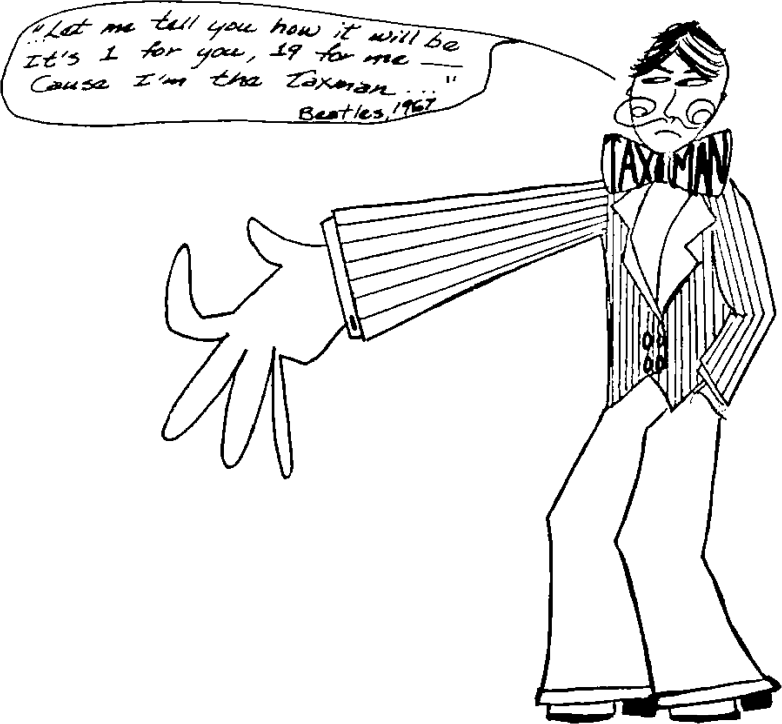
But the People’s Computer Company magazine archive is a sunny thing, overfilled with joyful amateur enthusiasm and thousands of lines of code fit to make Edsger Dijkstra explode. Of course it was written for the local few who had access to mainframes and terminals, but it hardly seems to come from the same world as the dark evenings in Scotland spent cursing the smug neighbours’ house with all the lights on, their diesel generator putt-putting into the night.
Lots of these games from the PCC era are forgettable now. The raw challenge of guessing a number on a text screen has paled somewhat in the face of 4K photo-realistic rendering. One game I found is still a little challenging, at least until you work out the trick of it: Taxman (or as the authors tried to rename it later, Factor Monster). Here’s a tiny sample game transcript:
Hi, I'm the taxman Do you want the regulations? (1=Yes, 0=No)? 0 How many numbers do you want in the list? 6 The list is: 1 2 3 4 5 6 You take? 5 Your total is 5 I get 1 My total is 1 New list: 2 3 4 6 You take? 6 Your total is 11 I get 2 3 My total is 6 New list: 4 I get 4 because no factors of any number are left. My total is 10 You 11 Taxman 10 You win !!! Again (1=yes, 0=no)?
Seems I sneaked a lucky win there, but it’s harder than it looks. The rules are simple:
- Start with a list of consecutive numbers
- You choose a number, but it has to have some factors in the list
- The taxman (or the factor monster, a concept I much prefer as it doesn’t reinforce the Helmsley Doctrine) takes all the remaining factors of your number from the list
- You get to choose a number from the list, which is now missing your previous choice and all of its factors, and repeat
- Once the list has no multiples of any other number, the taxman/FM takes the rest
- The winner is whoever has the largest sum.
For such a simple game (or perhaps, such a simple me) the computer wins surprisingly often. Since I find it fun to play, I thought I’d share the 1973 love as much as possible by porting to all of the BASIC dialects that I knew.
Plain text BASIC – taxman.bas – runs under interpreters such as bas. Almost verbatim from the 1973 publication. May not allow you to play again on some interpreters; you might want to try my slightly rearranged 40 column version that should run on systems that don’t allow a variable to be dimensioned twice.
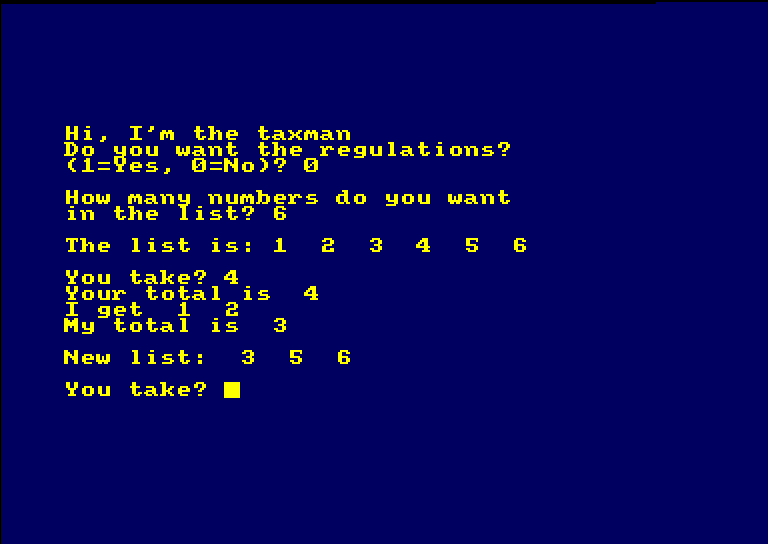
Amstrad CPC Locomotive BASIC – taxman.dsk – or as I call it, BASIC. 40 columns yellow on blue is how BASIC should look.
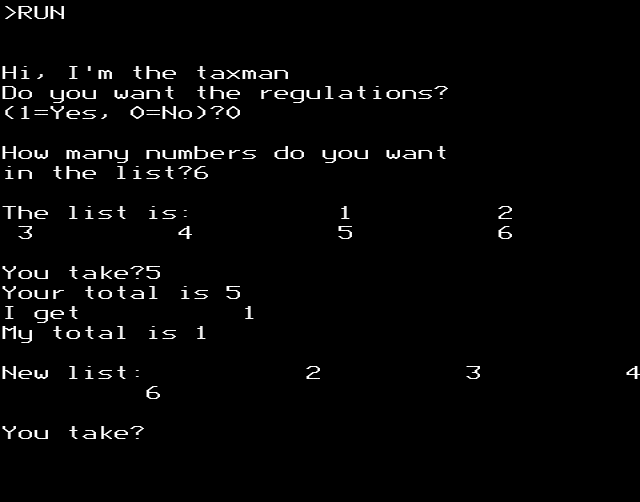
BBC BASIC – taxman.ssd – for all the boopBeep fans out there. You can actually play this one in your browser, too. Yes, the number formatting is weird, but BBC BASIC was always its own master.
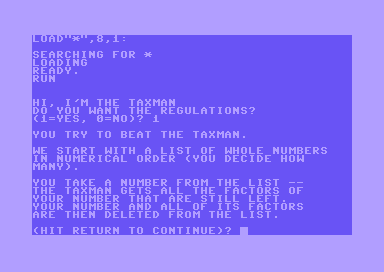
Commodore 64 – taxman.prg – very very upper case for this dinosaur of a BASIC.
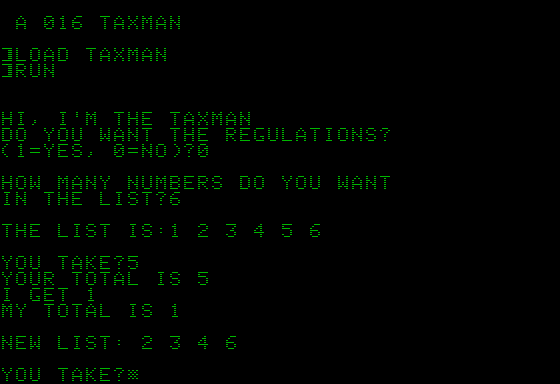
Apple II AppleSoft BASIC – TAXMAN.DSK – lots of fiddling with import tools and dialect weirdness because Apple.
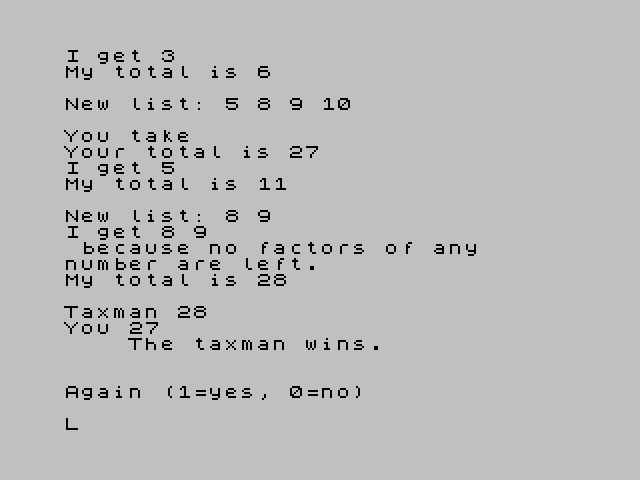
ZX Spectrum (Sinclair BASIC) – taxman.tap – 32 columns plus a very special dialect (no END, GOTO and GOSUB are GO TO and GO SUB) meant this took a while, but it was quite rewarding to get going.
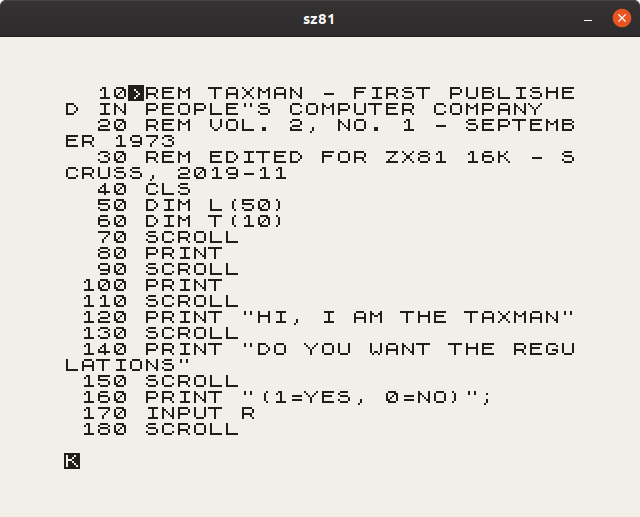
Sinclair ZX81 (16 K) – taxman.p – this one was a fight. The ZX81 didn’t scroll automatically, so you have to invoke SCROLL before every newline-generating PRINT or else your program will stop. For some reason this version gets unbearably slow near the end of long games, but it does complete.
moar 10PRINT nonsense
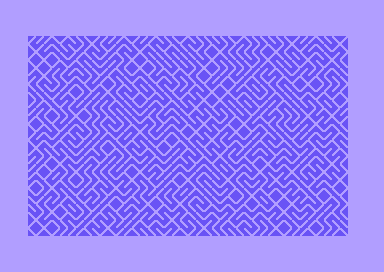
but this still owns it:
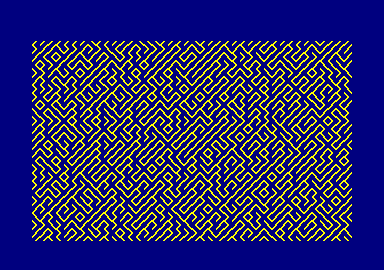
I found I can get this to preload in an emulator, but you still have to type RUN and hit return. See, look: http://scruss.com/cpc/6128s.html?stardoj.dsk/10%20PRINT%20CHR$(199+2*RND);:%20GOTO%2010
Rob Manuel’s British Council Tile / Bus Fabric Sim
Rob’s British Council Tile / Bus Fabric Sim — described here: Amstrad BASIC that approximates the tiling schemes that a local council might have used for a municipal building in the 1970s — is a joy. So few colours!
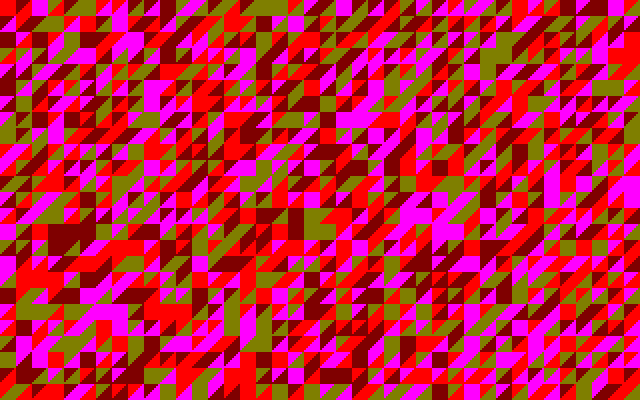
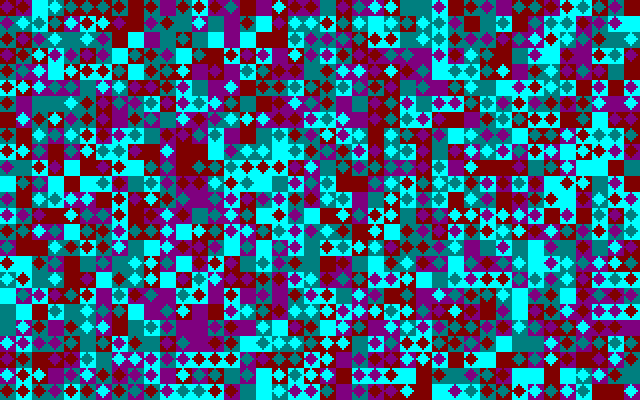
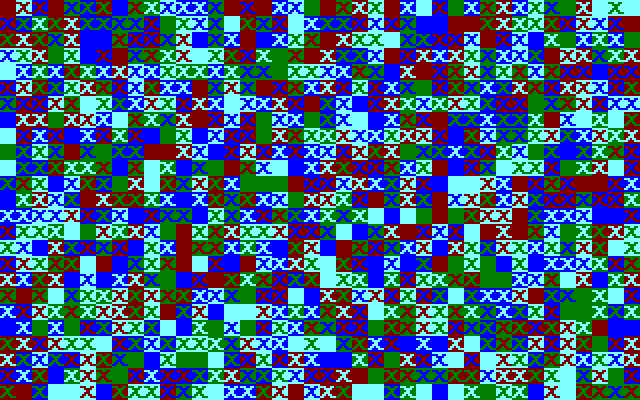

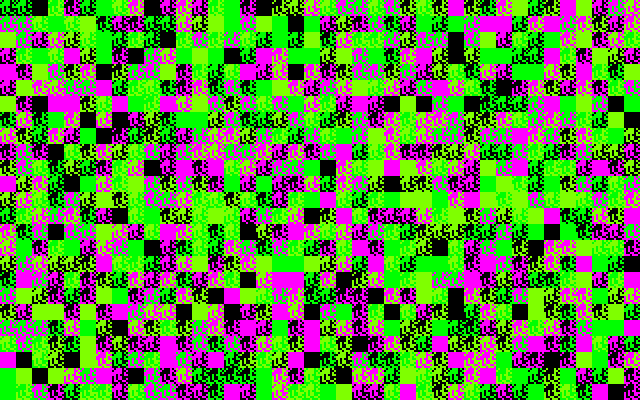
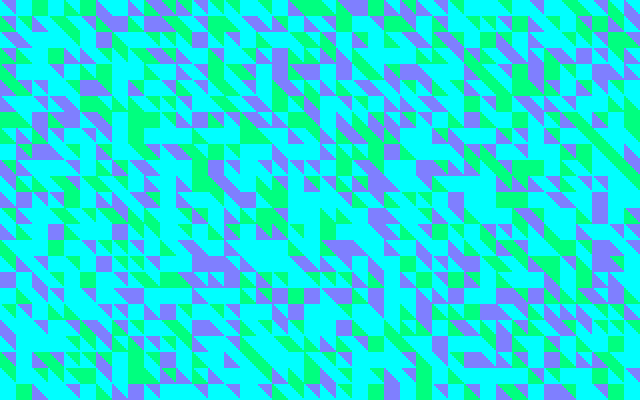
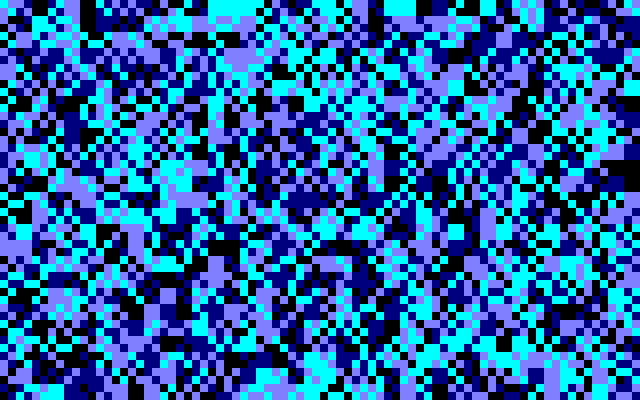 Because I care (and don’t if you don’t), here’s the Locomotive BASIC source, lovingly typed into the Caprice32 emulator then extracted as text using iDsk:
Because I care (and don’t if you don’t), here’s the Locomotive BASIC source, lovingly typed into the Caprice32 emulator then extracted as text using iDsk:
10 ' British Council Tile / Bus Fabric Sim
20 ' by Rob Manuel 2018
30 '
40 ' z/x - change char up/down (ascii)
50 ' space - random palette
60 ' c - show ascii val, inks & pause
70 ' v - random character (128+ ascii)
80 ' b - random char and cols
90 ' n - fill with same line & pause
100 'i - input ascii value
110 '
120 ON BREAK GOSUB 260:MODE 1:LOCATE 1,26
130 DEF FNs=INT(RND*255)
140 SYMBOL 255,FNs,FNs,FNs,FNs,FNs,FNs,FNs,FNs
150 DEF FNp=INT(RND*4)
160 DEF FNi=INT(RND*26)
170 GOSUB 470
180 GOSUB 270
190 o$="":i$=INKEY$
200 IF i$<>"" THEN GOSUB 380
210 FOR i=1 TO 40
220 w$=CHR$(14)+CHR$(FNp)+CHR$(15)+CHR$(FNp)
230 w$=w$+CHR$(c):o$=o$+w$:NEXT i
240 store$=o$
250 PRINT o$;:GOTO 190
260 CALL &BC02:PAPER 0:PEN 1:END
270 aa=FNi:bb=FNi:cc=FNi:dd=FNi
280 INK 0,aa:INK 1,bb:INK 2,cc:INK 3,dd
290 BORDER aa
300 GOSUB 320:RETURN
310 IF c>255 THEN c=32:IF c<32 THEN c=255
320 LOCATE 1,1:PAPER 0:PEN 1
330 PRINT "C:"c;
340 PRINT CHR$(c);
350 PRINT " ";
360 PRINT "I:"aa;bb;cc;dd;
370 LOCATE 1,26:RETURN
380 IF i$=" " THEN GOSUB 270:RETURN
390 IF i$="z" THEN c=c-1:GOSUB 310:RETURN
400 IF i$="x" THEN c=c+1:GOSUB 310:RETURN
410 IF i$="c" THEN GOSUB 310:CALL &BB18:RETURN
420 IF i$="i" THEN LOCATE 1,1:INPUT "ASCII?",c:GOSUB 310:RETURN
430 IF i$="v" THEN GOSUB 470:GOSUB 310:RETURN
440 IF i$="b" THEN GOSUB 270:GOSUB 470:GOSUB 310:RETURN
450 IF i$="n" THEN FOR i=1 TO 25:PRINT store$;:NEXT:CALL &BB18:RETURN
460 RETURN
470 c=INT(RND*128)+127:RETURN
And if you really care, here’s an emulator snapshot — BritishCouncilTileSim.zip
Update: I modified the code slightly (essentially, all INT(RND*n) to RND MOD n) so it would compile with Hisoft Turbo Basic. It works! It’s faster!
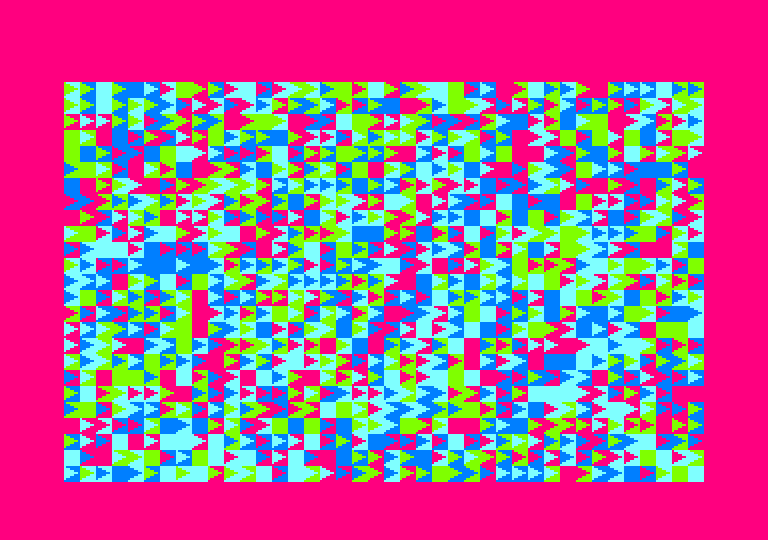 Snapshot: BritishCouncilTileSimCompiled.zip
Snapshot: BritishCouncilTileSimCompiled.zip
it always was the better computer …
Protext lives!
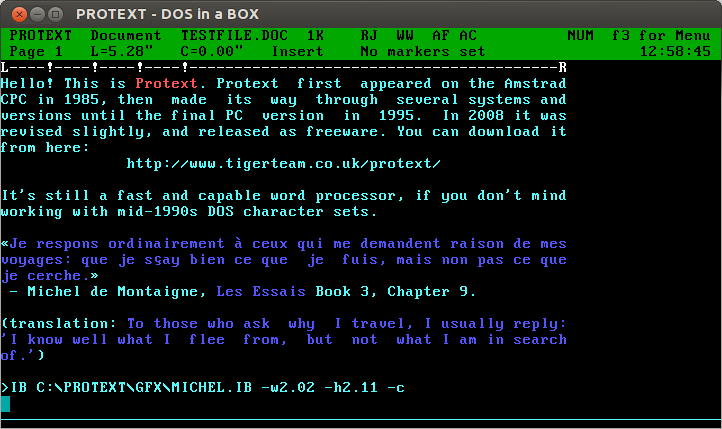
Oh man, Protext! For years, it was all I used: every magazine article, every essay at university (all two of them), my undergraduate dissertation (now mercifully lost to time: The Parametric Design of a Medium Specific Speed Pump Impeller, complete with spline-drawing code in HiSoft BASIC for the Amiga, is unlikely to be of value to anyone these days), letters — you name it, I used Protext for it.
I first had it on 16kB EPROM for the Amstrad CPC464; instant access with |P. I then ran it on the Amiga, snagging a cheap copy direct from the authors at a trade show. I think I had it for the PC, but I don’t really remember my DOS days too well.
The freeware version runs quite nicely under dosemu. You can even get it to print directly to PDF:
- In your Linux printer admin, set up a CUPS PDF printer. Anything sent to it will appear as a PDF file in the folder ~/PDF.
- Add the following lines to your ~/.dosemurc:
$_lpt1 = “lpr -l -P PDF”
$_printer_timeout = (20) - In Protext, configure your printer to be a PostScript printer on LPT1:
The results come out not bad at all:
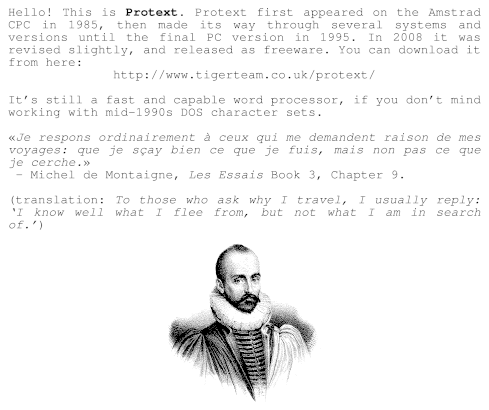 Protext’s file import and export is a bit dated. You can use the CONVERT utility to create RTF, but it assumes Code page 437, so your accents won’t come out right. Adding \ansicpg437 to the end of the first line should make it read okay.
Protext’s file import and export is a bit dated. You can use the CONVERT utility to create RTF, but it assumes Code page 437, so your accents won’t come out right. Adding \ansicpg437 to the end of the first line should make it read okay.
(engraving of Michel de Montaigne in mad puffy sleeves: public domain from Wikimedia Commons: File:Michel de Montaigne 1.jpg – Wikimedia Commons)
Sorry, folks …
Sorry, folks at 10 PRINT, I think the Amstrad CPC’s version simply pwns the C64:
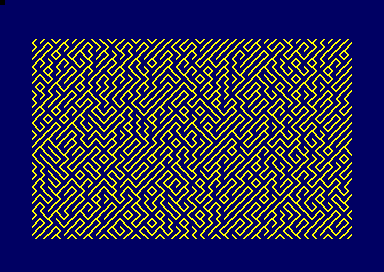
Painfully Slow Amstrad CPC Emulation on the Raspberry Pi
Yeah, you can do it, but whether you should, I don’t know. Download the latest Arnold/Linux source, then (according to this post) after installing the dependencies, you just need to change
TARGET_FMT=elf32-i386to
TARGET_FMT=elf32-littlearmin src/Makefile.in.
It works, for very slow values of “works”. Mind you, I was running it through a remote X session, so 2 fps is all I could have hoped for …
Sometimes, things do not go exactly as planned … C development for Amstrad CPC on Raspberry Pi
Hey! This is ancient! But since we’re talking about even more ancient computers, those bits still work. I’d recommend looking at the current installation instructions for z88dk rather than what I’ve got here.

If you crash an Amstrad CPC, you often got some pretty patterns. Like the one above, which was supposed to print the alphabet, but got about as far as R, then started making coloured spots on the screen. My alphabet doesn’t (usually) contain coloured spots, so something went wrong.
This post is only about the Raspberry Pi in that it’s the nearest always-on Linux system that I have. This would likely work fine on any Linux machine. While the Z80 cross compiler I use (z88dk) is available in the repos, I can’t get it to build anything, so I just pulled down the latest version. To build the compiler:
wget http://nightly.z88dk.org/z88dk-latest.tgz
tar xvzf z88dk-latest.tgz
cd z88dk
export Z80_OZFILES=$(pwd)/lib/
export ZCCCFG=${Z80_OZFILES}config/
export PATH=${PATH}:$(pwd)/bin
./build.sh
This should result in a working environment. We can test it with a simple C program:
/* alfa.c - print the alphabet */
#include <stdio.h>
int main(void) {
char a='A';
char b=26;
while (b>0) {
putchar(a);
a++;
b--;
}
}
You can build it with:
zcc +cpc -create-app -make-app -O3 -unsigned -o alfa.bin alfa.c -lcpcfs -zorg=16384
You should end up with a file alpha.bin of approximately 4749 (!) bytes. You can copy it to a disc image using iDSK:
iDSK blank.dsk -i alfa.bin -c 4000 -e 4000 -t 1
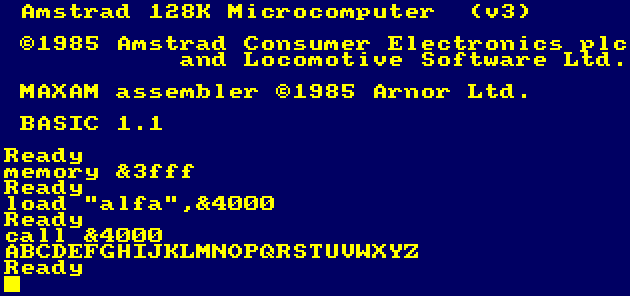
It runs like this:
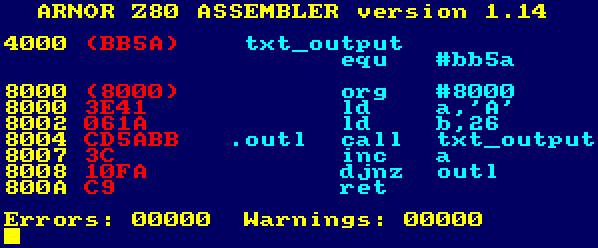
You can do the same with Z80 assembly language (shown here in the most gratuitously pretty Amstrad assembler, Maxam):
Although this results in only 11 bytes of code, it’s not portable; the C code above compiled and ran on both my Raspberry Pi and my Mac. It wouldn’t even run properly on a different Z80 system, as only the Amstrad CPC knows that call #bb5a prints the character in the A register. On the ZX Spectrum, for example, it was the completely different instruction rst 16 to print a character.
(There’s a lot more on z88dk on the CPCWiki.)
2D Star Dodge flies again!
There’s rather more nostalgia in this post than I’d want to deal with. If you want to just play the game, go here here and skip this blurb.
Update: the Java emulator doesn’t work in the browser any more, so here’s Arnold playing the BASIC version: http://scruss.com/cpc/6128s.html?stardoj.dsk/run%22stardoj2
About 25 years ago, I was a smallish computer nerd obsessed with programming his Amstrad CPC464. I had got a BCPL rom-based compiler for cheap and was looking for things to do with it. “Why not write a game?” I asked myself.
There were two minor hurdles. I had no imagination, and I certainly wasn’t focused enough to write anything big. Fortunately, it was still the 80s, so we knew how to rip stuff off without being called out for it. I merrily copied a game my friend Alan Cook had written for the Dragon 32, and called it 2D Star Dodge.
2D Star Dodge was the perfect rip off. Not merely had I ripped off the idea from Alan, but he had ripped off the idea in turn from a BBC Basic one-liner game called (as verified by Graeme Smith) “One Line” Asterisk Tracker. The name 2D Star Dodge was an, um, homage to Realtime Games’ 3D Starstrike, which itself was “strongly influenced” by the Star Wars arcade game. Originality? Pfft.
So I wrote the game. Well, okay, I wrote a mockup in Locomotive BASIC, which ran a bit slowly, but gave me something to work from. Here it is, if you want to play it in you (Java-enabled) browser: 2D Star Dodge – BASIC. I then meticulously translated it into BCPL, and ended up with something that looked liked this:
 (if you click on that image, you can play the BCPL version in your browser.)
(if you click on that image, you can play the BCPL version in your browser.)
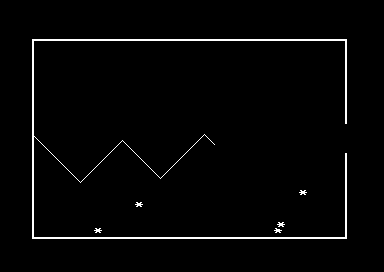
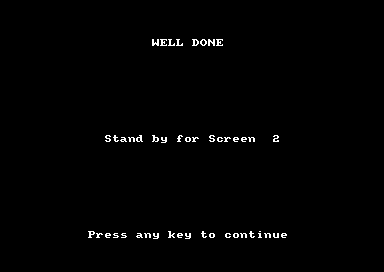
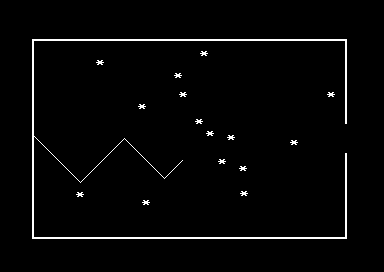
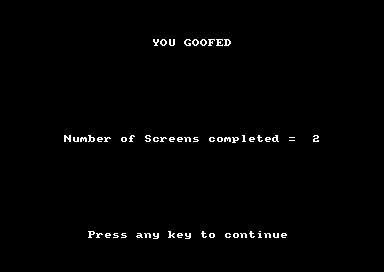
Â
The gameplay — press a key to go up, stop pressing a key to go down — is a bit like SFCave (obligatory Java version: Lab6 SFCave) or even my current favourite Tiny Wings.
Once I’d finished the BCPL version, I had bought the MAXAM assembler ROM, and got learning the Z80 opcodes. Soon, a third port was complete, now needing hardcoded delays to be playable as it would kill you off in about one screen refresh without them.
So, now I had three versions of the same game. There was only a limited number of local folks I could give it to, so I decided to send all three versions to Amstrad Computer User magazine to print as a type-in. Thankfully, it arrived on the desk of the freshly minted (yet still beardy) assistant editor Jeff Walker, who had founded the jam econo CPC magazine/club WACCI. Jeff had the idea for me to turn the simple game into a comparison of programming in three languages.
Thanks to the CPCWiki forum, you can now read the articles I wrote in Amstrad Computer User in 1988 that went with the code. Writing style best described as “typing”:
- Amstrad Computer User 1988/09 – Star Dodger 1 – BASIC
- Amstrad Computer User 1988/10 – Star Dodger 2 – BCPL
- Amstrad Computer User 1988/11 – Star Dodger 3 – Assembler
To play the game in an astonishing JavaScript emulator:
- Download this disc image file: stardoj
- Unzip it
- Go to CPCBox
- “Choose configuration …” of Boot CPC464 (or 664, or 6128)
- Select your downloaded stardoj.dsk as Drive A:
- Annoyingly, it seems to be stuck with an AZERTY keymap, so to catalogue the disc (
cat) you have to typecqt - To run the BASIC version, type
run"stardoj2(on my American keyboard, that becomesrun@stqrdoj2; quotes are Shift+2). Hitting Escape twice will quit back to the prompt. - To run the BCPL version, type
run"2dstardo. The only way to quit is to reset the emulator.
The BASIC version is based on the published type-in. The BCPL version I found as a disk image (2dstardo.dsk) on a download site — it’s exactly as I submitted it to the magazine, dubious copyright message and all. I’m not sure how it got out there; I suspect either my network of, ahem, software protection experts I knew through Colin Harris of Nemesis, or it went via my CPC-owning French penpal (Hi Benoit Hébert, formerly of Le Havre).
I had to modify the BCPL binary to run on modern emulators, as the real Amstrad CPC did a thing with its keymapping that is really hard to get right on modern systems. Originally, the game used the Shift key, but I modified it to use Space, which is easier to emulate as it’s a printing character. Can I just say that I remembered how to read and modify Z80 binaries after a quarter century? Old school, literally. I used iDsk‘s disassembler/hex dumper and emacs’s hexl mode to do the deed.
I recently discovered that someone created a Flash game based on my type-in: Star Dodger. Mind = Blown.
Update, 2018: Lawks! Someone wrote a PureScript version! It doesn’t exactly work for me on Firefox, but it does on Chromium.
Amstrad CPC INKEY codes
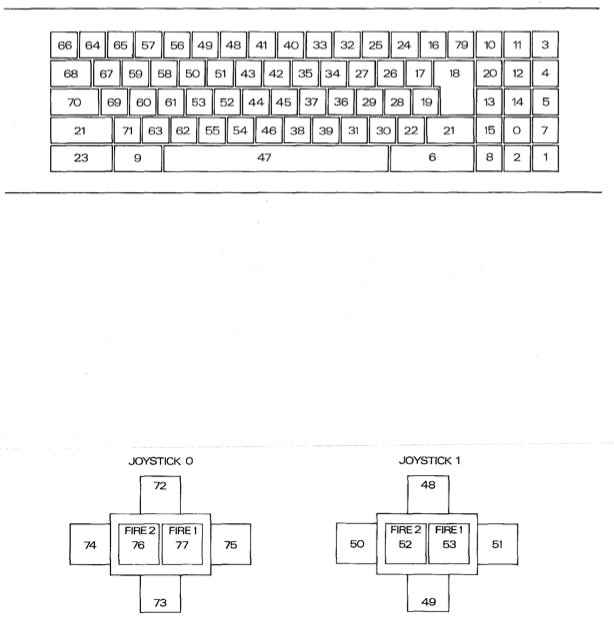
Ganked from the CPC 6128 manual. You’re welcome …
Note that non-printing keys (like SHIFT) are really hard to emulate on modern machines. The CPC scanned them as if they were any printing key, but modern machines handle them like key modifiers.
CPC – a provisional bitmap font
This isn’t quite right yet – characters aren’t encoded correctly, and it’s not quite as monospaced as it should be, but it has some nostalgia value. It’s the screen font used by the Amstrad CPC.

Font: CPC-0.9.zip
my juvenalia: 2D Star Dodge / Stardodger
Oh dear:
 And here’s the Locomotive BASIC version, as published in Amstrad Computer User:
And here’s the Locomotive BASIC version, as published in Amstrad Computer User:
10 ' ** Initialise ** 20 MODE 1 30 INK 0,0 40 BORDER 0 50 INK 1,26 60 INK 3,0 70 q=5 90 LOCATE 16,1 100 PRINT"Stardodger" 110 LOCATE 1,5 120 PRINT"Avoid the killer Asterisqs, and seek the" 130 LOCATE 9,6 140 PRINT"wondrous Nextscreen Gap." 150 LOCATE 12,13 160 PRINT"Use SHIFT to climb" 170 GOSUB 700 190 MODE 1 200 DRAWR 629,0 210 DRAWR 0,170 220 MOVER 0,60 230 DRAWR 0,169 240 DRAWR -629,0 250 DRAWR 0,-399 260 DRAWR 0,2 270 DRAWR 627,0 280 DRAWR 0,168 290 MOVER 0,60 300 DRAWR 0,167 310 DRAWR -625,0 320 DRAWR 0,-399 330 MOVE 636,0 340 DRAW 636,399,3 350 MOVE 638,0 360 DRAW 638,399 370 PLOT -1,-1,1 380 TAG 390 FOR s=1 TO q 400 MOVE 50+RND*561,20+RND*361 410 PRINT"*"; 420 NEXT 430 TAGOFF 440 MOVE 0,200 450 dy=4 470 DRAWR 4,dy 480 IF INKEY(21)<>-1 THEN dy=4 ELSE dy=-4 490 t=TESTR(2,dy/2) 500 IF t=1 GOTO 550 510 IF t=3 GOTO 620 520 MOVER -2,-dy/2 530 GOTO 470 550 MODE 1 560 PRINT TAB(16);"YOU GOOFED" 570 LOCATE 5,13 580 PRINT"Number of Screens completed = "+STR$((q/5)-1) 590 GOSUB 700 600 RUN 620 MODE 1 630 PRINT TAB(16);"WELL DONE" 640 LOCATE 10,13 650 PRINT"Stand by for Screen "+STR$((q/5)+1) 660 GOSUB 700 670 q=q+5 680 GOTO 190 700 LOCATE 8,25 710 PRINT"Press any key to continue" 720 WHILE INKEY$<>"" 730 WEND 740 WHILE INKEY$="" 750 WEND 760 RETURN
Here’s Asterisk Tracker, the original inspiration from 1984
spent too much time in the henhouse
The Chuckie Egg Professional’s Resource Kit (warning: loud embedded YouTube video of the BBC B version) is a worryingly complete website about Chuckie Egg. You don’t know Chuckie Egg?
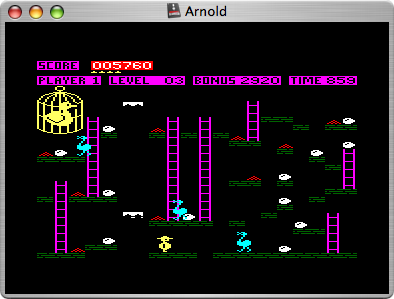
 You should. I’ve probably spent more time playing this than any other computer game. It was even my workhorse for testing how quickly my fast tape loading routines worked on the Amstrad (I think I got somewhere north of 9000 baud on a good tape, and it loaded back more than once, so – success!)
There are emulators and versions for just about every computer made, so go nuts.
All the printers I’ve ever owned …

- An ancient (even in 1985) Centronics serial dot-matrix printer that we never got working with the CPC464. The print head was driven along a rack, and when it hit the right margin, an idler gear was wedged in place, forcing the carriage to return. Crude, noisy but effective.
- Amstrad DMP-2000. Plasticky but remarkably good 9-pin printer. Had an open-loop ribbon that we used to re-ink with thick oily endorsing ink until the ribbons wore through.
- NEC Pinwriter P20. A potentially lovely 24-pin printer ruined by a design flaw. Print head pins would get caught in the ribbon, and snap off. It didn’t help that the dealer that sold it to me wouldn’t refund my money, and required gentle persuasion from a lawyer to do so.
- Kodak-Diconix 300 inkjet printer. I got this to review for Amiga Computing, and the dealer never wanted it back. It used HP ThinkJet print gear which used tiny cartridges that sucked ink like no tomorrow; you could hear the droplets hit the page.
- HP DeskJet 500. I got this for my MSc thesis. Approximately the shape of Torness nuclear power station (and only slightly smaller), last I heard it was still running.
- Canon BJ 200. A little mono inkjet printer that ran to 360dpi, or 720 if you had all the time in the world and an unlimited ink budget.
- Epson Stylus Colour. My first colour printer. It definitely couldn’t print photos very well.
- HP LaserJet II. Big, heavy, slow, and crackling with ozone, this was retired from Glasgow University. Made the lights dim when it started to print. Came with a clone PostScript cartridge that turned it into the world’s second-slowest PS printer. We did all our Canadian visa paperwork on it.
- Epson Stylus C80. This one could print photos tolerably well, but the cartridges dried out quickly, runing the quality and making it expensive to run.
- Okidata OL-410e PS. The world’s slowest PostScript printer. Sold by someone on tortech who should’ve known better (and bought by someone who also should’ve known better), this printer jams on every sheet fed into it due to a damaged paper path. Unusually, it uses an LED imaging system instead of laser xerography, and has a weird open-hopper toner system that makes transporting a part-used print cartridge a hazard.
- HP LaserJet 4M Plus. With its duplexer and extra paper tray it’s huge and heavy, but it still produces crisp pages after nearly 1,000,000 page impressions. I actually have two of these; one was bought for $99 refurbished, and the other (which doesn’t print nearly so well) was got on eBay for $45, including duplexer and 500-sheet tray. Combining the two (and judiciously adding a bunch of RAM) has given me a monster network printer which lets you know it’s running by dimming the lights from here to Etobicoke.
- IBM Wheelwriter typewriter/ daisywheel printer. I’ve only ever produced a couple of pages on this, but this is the ultimate letter-quality printer. It also sounds like someone slowly machine-gunning the neighbourhood, so mostly lives under wraps.
- HP PhotoSmart C5180. It’s a network photo printer/scanner that I bought yesterday. Really does print indistinguishably from photos, and prints direct from memory cards. When first installed, makes an amusing array of howls, boinks, squeals, beeps and sproings as it primes the print heads.
no work shall be done

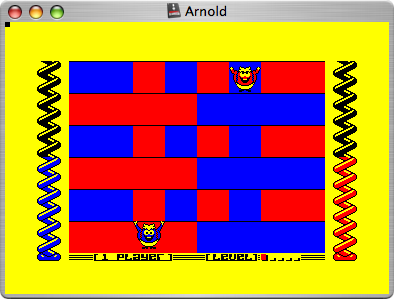
Oh dear, I’ve just discovered Arnold, the Amstrad CPC emulator for OS X. The CPC was my first home computer, and I have fond memories. What with that, and the ftp.nvg.ntnu.no games archive, I’ll be as happy as a pig in glabber.

